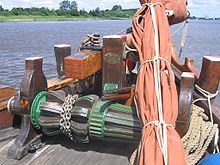Spill
The capstan (also capstan , derived from spindle) is a rotatable device for hauling in cables or the anchor chain (anchor capstan), or for lifting heavy loads. Pawls ( pawls ) prevent the capstan from turning backwards. It is powered by muscle power, an electric or diesel engine.
The spill differs from the winch in that the fetched rope is not wound: the force is transmitted only by the friction of several on the drum lying trips (Tauwerkswindungen) or, for chains, via a chain sprocket . A capstan can therefore attach any length of rope or chain.
A capstan with a horizontal wave is called a frying cap .
The capstan is a muscle-powered capstan with a vertical shaft. It consists of a shaft (with the drum, a fitting to hold the anchor chain or a hawser) and the capstan head, which is provided with openings for inserting the capstan pegs. The latter are one to two meters long pieces of wood on which up to four men walked in a circle. In this shanties sung to adhere to the steady rhythm of monotonous work and work to lift the mood of the team. With the introduction of steam engines on board, capstans became obsolete; today they can only be found on historical ships (e.g. on the Amphitrite ).
- What is called a winch (sheet winch ) in today's parlance is actually a capstan (more precisely: a crank capstan).
- Multi-turn crank capstans, which can optionally be coupled to one of several external drums via a shaft, are common on racing yachts and are called coffee grinders .



